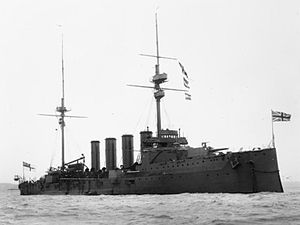HMS Duke of Edinburgh
 |
|
| History | |
|---|---|
|
|
|
| Name: | HMS Duke of Edinburgh |
| Namesake: | Alfred, Duke of Saxe-Coburg and Gotha, Duke of Edinburgh |
| Ordered: | 1902/1903 Naval programme |
| Builder: | Pembroke dockyard |
| Laid down: | 11 February 1903 |
| Launched: | 14 June 1904 |
| Completed: | 20 January 1906 |
| Struck: | 1919 |
| Fate: | sold 12 April 1920 |
| General characteristics | |
| Class and type: | Duke of Edinburgh-class armoured cruiser |
| Displacement: |
|
| Length: | 505 ft 6 in (154.1 m) |
| Beam: | 73 ft 6 in (22.4 m) |
| Draught: | 27 ft (8.2 m) (maximum) |
| Installed power: | 23,000 ihp (17,000 kW) |
| Propulsion: |
|
| Speed: | 23 knots (43 km/h; 26 mph) |
| Range: | 8,130 nmi (15,060 km; 9,360 mi) at 10 knots (19 km/h; 12 mph) |
| Complement: | 789 |
| Armament: |
|
| Armour: | |
HMS Duke of Edinburgh was the lead ship of the Duke of Edinburgh-class armoured cruisers built for the Royal Navy in the mid-1900s. She was stationed in the Mediterranean when the First World War began and participated in the pursuit of the German battlecruiser SMS Goeben and light cruiser SMS Breslau. After the German ships reached Ottoman waters, the ship was sent to the Red Sea in mid-August to protect troop convoys arriving from India. Duke of Edinburgh was transferred to the Grand Fleet in December 1914 and participated in the Battle of Jutland in May 1916. She was not damaged during the battle and was the only ship of her squadron to survive. She was eventually transferred to the Atlantic Ocean in August 1917 for convoy escort duties.
The ship was sold for scrap in 1920.
Duke of Edinburgh displaced 12,590 long tons (12,790 t) as built and 13,965 long tons (14,189 t) fully loaded. The ship had an overall length of 505 feet 6 inches (154.1 m), a beam of 73 feet 6 inches (22.4 m) and a draught of 27 feet (8.2 m). She was powered by four-cylinder triple-expansion steam engines, driving two shafts, which produced a total of 23,000 indicated horsepower (17,150 kW) and gave a maximum speed of 23 knots (43 km/h; 26 mph). The engines were powered by 20 Babcock & Wilcox water-tube boilers and six cylindrical boilers. The ship carried a maximum of 2,150 long tons (2,180 t) of coal and an additional 600 long tons (610 t) of fuel oil that was sprayed on the coal to increase its burn rate. At full capacity, she could steam for 8,130 nautical miles (15,060 km; 9,360 mi) at a speed of 10 knots (19 km/h; 12 mph). The ship's complement was 789 officers and enlisted men.
...
Wikipedia
